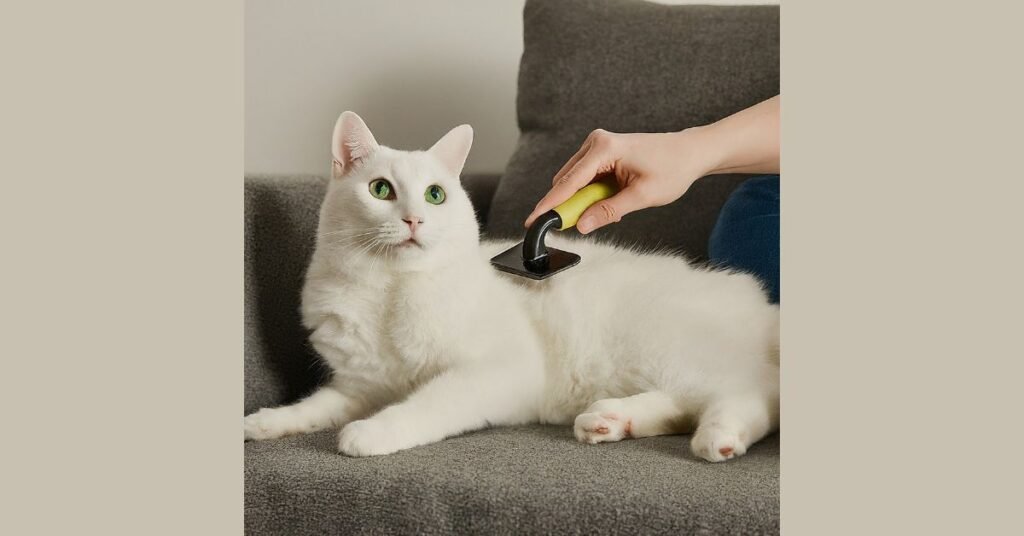Our feline companions are meticulous groomers by nature. Their dedication to keeping their fur clean and shiny is a joy to witness. But did you know that a change in your cat’s grooming habits can be an early sign of an underlying skin condition?
This blog post delves into the world of feline fur care, exploring how observing your cat’s grooming routine can be a valuable tool in detecting skin problems before they become serious.
From Pampering to Problem-Solving: Understanding Cat Grooming
Cats spend a significant portion of their day meticulously grooming themselves. This behavior serves several purposes:
- Hygiene: Cats remove dirt, debris, and parasites like fleas and ticks through licking and combing their fur with their rough tongues.
- Temperature Regulation: Licking helps distribute saliva, which evaporates and cools the body.
- Stress Relief: Grooming is a self-soothing behavior that can ease anxiety and discomfort.
When Grooming Becomes Excessive: Signs to Watch Out For
While a healthy cat will groom regularly, a sudden increase in grooming activity can be a red flag. Here are some signs to watch for:
- Frantic Licking: If your cat seems to be licking themselves excessively, particularly in specific areas, it could indicate itching or irritation.
- Hair Loss: Noticeable bald patches or increased shedding can be a sign of skin problems.
- Visible Skin Issues: Look for redness, inflammation, scabbing, or dandruff on your cat’s skin.
- Restlessness and Scratching: A cat constantly scratching or biting at their fur is likely experiencing discomfort.
- Changes in Behavior: If your typically social cat becomes withdrawn or irritable, it could be due to skin irritation.
Understanding the Cause: Common Skin Conditions in Cats
Several factors can contribute to skin problems in cats. Here are some of the most common culprits:
- Parasites: Fleas, ticks, and mites can cause intense itching and irritation.
- Allergies: Cats can develop allergies to food, environmental triggers like pollen, or even flea bites.
- Bacterial and Fungal Infections: Skin infections can occur due to scratches or underlying health conditions.
- Stress: Anxiety can manifest in cats as excessive grooming and skin problems.
- Dietary Deficiencies: A lack of essential nutrients can lead to a dull coat and skin issues.
Early Detection is Key: What to Do if You Notice Changes
If you observe any signs of excessive grooming or skin problems in your cat, don’t hesitate to schedule an appointment with your veterinarian. Early detection is crucial for effective treatment and preventing further discomfort for your feline friend.
During the appointment, your vet will thoroughly examine your cat’s skin and fur. They may recommend additional tests like skin scrapings or blood work to determine the underlying cause. Treatment options will vary depending on the diagnosis and may include:
- Flea and parasite control medications
- Antibiotics or antifungal medication for infections
- Allergy medication or dietary changes
- Supplements to improve skin health
Keeping Your Cat’s Skin Healthy: Preventative Measures
Here are some tips to help maintain your cat’s healthy skin and coat:
- Regular Brushing: Brushing your cat helps remove loose fur, stimulate natural oils, and detect any skin abnormalities.
- Balanced Diet: Provide your cat with a high-quality diet rich in essential fatty acids for healthy skin and fur.
- Parasite Prevention: Use veterinarian-approved flea and tick preventatives year-round.
- Stress Management: Enrich your cat’s environment with scratching posts, toys, and hiding spots to reduce stress.
Conclusion
By paying close attention to your cat’s grooming habits, you can become a pro at detecting potential skin problems early on. Remember, a healthy coat is a reflection of a healthy cat. With a little vigilance and proactive care, you can ensure your feline friend stays happy, comfortable, and sports a gorgeous, healthy coat!
FAQs
-
Can I treat my cat’s skin condition at home?
While you can certainly support your cat’s skin health with a balanced diet and regular brushing, diagnosing and treating underlying skin conditions requires professional guidance. Consulting your veterinarian is crucial to ensure proper diagnosis and treatment. Never attempt to treat your cat with over-the-counter medications intended for humans, as these can be harmful.
-
What are some signs of a severe skin condition?
If your cat experiences open sores, bleeding, or excessive hair loss alongside other symptoms, it could indicate a more serious underlying condition. Seek immediate veterinary attention if you notice any of these signs.
-
How often should I brush my cat?
The frequency of brushing depends on your cat’s fur length. Longhaired cats generally require daily brushing to prevent matting and detect skin problems. Shorthaired cats can benefit from brushing several times a week.
-
What are some signs of food allergies causing skin issues?
If your cat’s skin problems are linked to food allergies, you might also notice digestive issues like vomiting or diarrhea. They may also develop recurrent ear infections.
-
Can stress cause skin problems in cats?
Absolutely! Stress can manifest in cats as excessive grooming, leading to hair loss and irritation. If you suspect your cat is stressed due to environmental changes, new pets, or other factors, consult your veterinarian for advice on stress management techniques. Providing enrichment activities and a calm environment can significantly improve your cat’s well-being.

